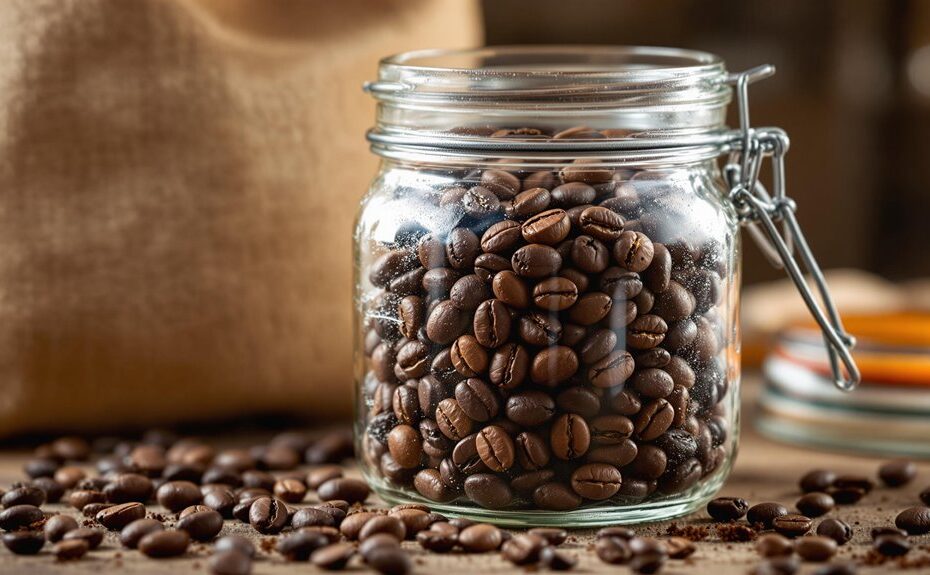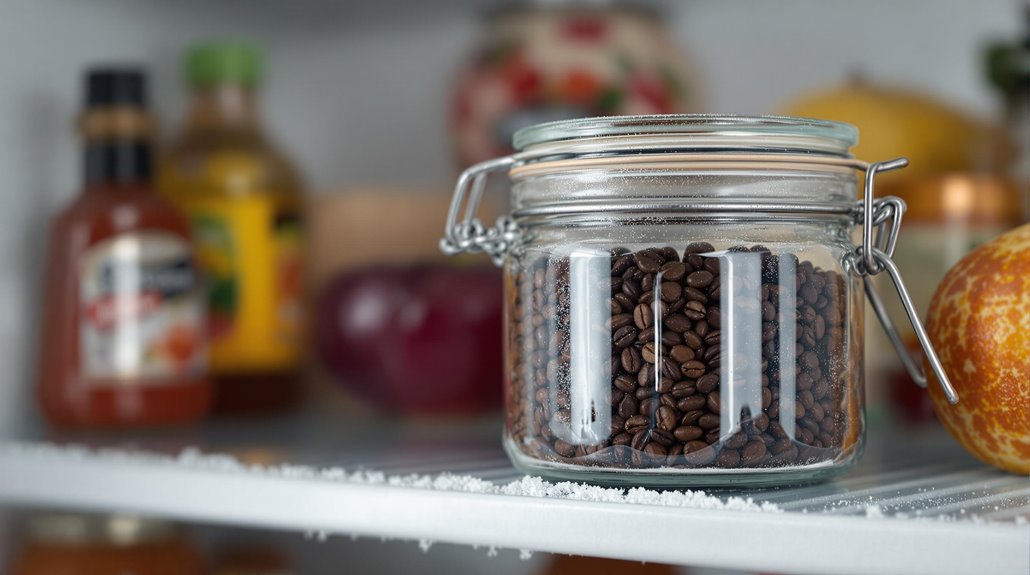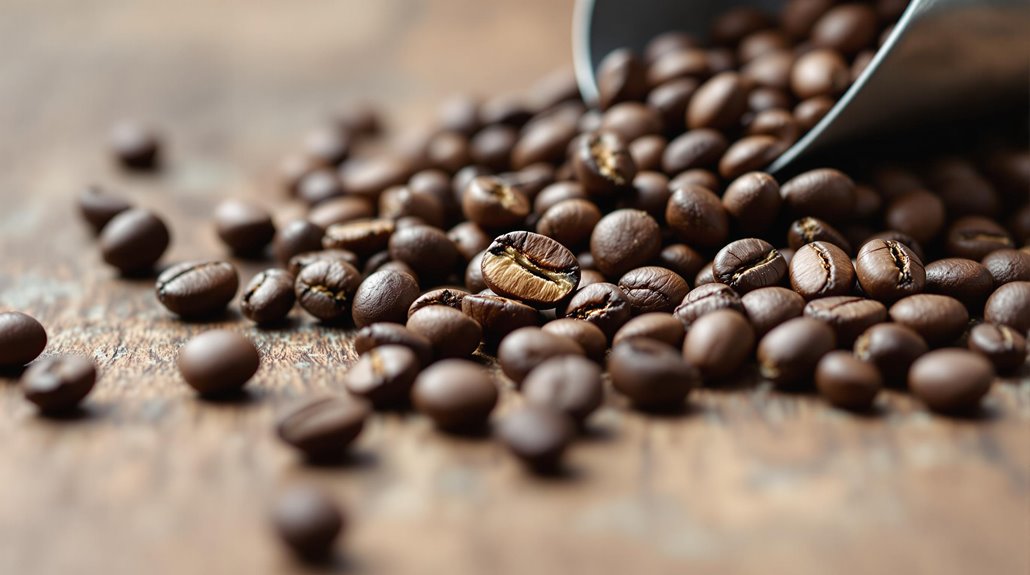







Like a fine wine, coffee's flavor is delicate and easily compromised by its environment. You might think tossing your beans in a cabinet is enough, but air, light, and moisture are stealthy thieves robbing your brew of its richness. Storing coffee properly isn't just about keeping it fresh—it's about preserving the experience. But what's the best way to lock in that aroma and taste? The answer lies in understanding how even the smallest details, from your container choice to storage temperature, can make or break your morning ritual. What you don't know could be costing you the perfect cup.
Key Takeaways
- Store coffee in airtight, opaque containers made of stainless steel, glass, or ceramic to block light, oxygen, and moisture.
- Keep coffee in a cool, dark place (60-75°F or 15-24°C) to prevent temperature fluctuations and preserve freshness.
- Freeze coffee in vacuum-sealed, single-use portions for long-term storage, and let it reach room temperature before opening.
- Use coffee within 2-4 weeks of roasting for peak freshness, as volatile compounds degrade over time.
- Avoid pre-grinding coffee; grind just before brewing to minimize oxidation and maintain flavor complexity.
Optimal Storage Conditions for Coffee Beans
To maintain the freshness of coffee beans, you'll want to focus on controlling their exposure to air, light, and temperature. Start by storing whole coffee beans in an airtight container to limit air movement, which can accelerate oxidation and degrade flavor. Choose containers made of materials like stainless steel or glass with airtight seals, as they block light and maintain temperature stability. Avoid plastic containers, as they can absorb odors over time and compromise the beans' quality.
Keep the container in a cool, dark place, ideally between 60-75°F (15-24°C), to prevent temperature fluctuations that can affect freshness. Avoid storing coffee in the refrigerator, as it introduces moisture and increases the risk of odor absorption. For short-term storage, opaque or dark-colored containers are ideal, as they block light effectively. If you're storing specialty or bulk coffee, consider using vacuum-sealed containers or one-way valve bags to minimize air exposure and extend freshness. By controlling these factors, you'll preserve the beans' aroma, flavor, and overall quality for longer.
Impact of Air, Moisture, and Light on Freshness
The freshness of coffee hinges on its delicate balance with environmental factors like air, moisture, and light. Oxygen exposure is one of the primary culprits in degrading coffee quality. When coffee comes into contact with air, it undergoes oxidation, a chemical process that breaks down its aromatic compounds and leads to stale, flat flavors. To preserve freshness, you must minimize oxygen exposure by storing coffee in airtight containers.
Moisture is another critical factor. Coffee is hygroscopic, meaning it readily absorbs water and odors from its surroundings. Excess moisture can cause spoilage, mold growth, and a musty taste, ruining the beans or grounds. Always keep your coffee in a dry environment to prevent this.
Light exposure, whether from sunlight or artificial sources, also accelerates the degradation of coffee. UV rays break down essential oils and compounds, resulting in a bland or stale flavor. To protect your coffee, store it in opaque containers that block light entirely. By controlling oxygen exposure, moisture, and light exposure, you'll maintain the integrity and flavor of your coffee for longer.
Freezing Coffee: Pros, Cons, and Best Practices
Freezing coffee can be a practical solution for extending its shelf life, but it requires careful handling to preserve quality. When you store coffee in the freezer, make sure it's vacuum-sealed to prevent exposure to moisture and odors, which can compromise flavor. Portion the coffee into single-use quantities to avoid repeated thawing and refreezing, as this can degrade its texture and taste. Always let frozen coffee reach room temperature before opening the container to prevent condensation, which introduces moisture and can ruin the beans. Freezing is ideal for long-term storage of specialty or bulk coffee, but it's not recommended for daily use, as prolonged freezing can alter aroma and taste over time. Avoid freezing coffee in its original packaging unless it's vacuum-sealed, as exposure to air and moisture accelerates staleness. By following these best practices, you can effectively use your freezer to maintain coffee freshness while minimizing risks to its quality.
Freshness Timeline and Degassing
After roasting, coffee undergoes a critical degassing process, where carbon dioxide naturally escapes from the beans. This degassing is essential for achieving peak freshness, as trapped carbon dioxide can lead to bitterness and uneven extraction during brewing. For filter brews, peak freshness occurs between 2 days and 4 weeks post-roast, while espresso beans maintain their best flavor for 1 to 6 weeks. Darker roasts require longer degassing periods compared to lighter roasts due to their more porous structure, which allows carbon dioxide to escape more slowly.
Roasters often label bags with a "Roasted on" date to help you track freshness. To guarantee you're consuming coffee within its prime window, aim to use beans within 2-4 weeks of roasting. Buying smaller quantities more frequently helps you stay within this timeframe. Proper degassing not only enhances flavor but also guarantees a balanced extraction, as excess carbon dioxide can interfere with water contact during brewing. By understanding the relationship between degassing and freshness, you can maximize the quality and enjoyment of your coffee.
Common Storage Mistakes and Maintenance Tips
Storing coffee improperly can quickly undermine its freshness, even if you've carefully selected high-quality beans. One common mistake is leaving coffee in grinder hoppers overnight. This exposes the beans to air and light, accelerating staleness and allowing oil buildup, which taints future grinds. To maintain coffee freshness, empty and clean the hopper nightly. Another error is relying on the original packaging for storage. These bags often lack airtight seals, letting air and moisture degrade the beans. Transfer your coffee to an airtight container immediately after opening. Overbuying is another pitfall; purchasing large quantities leads to prolonged storage, causing the beans to lose their aromatic compounds over time. Instead, buy smaller amounts more frequently to guarantee you're always using fresh coffee. Pre-ground coffee is particularly vulnerable; its increased surface area speeds up oxidation, resulting in stale coffee. Always grind just before brewing. Finally, neglecting grinder maintenance can compromise freshness. Residual oils and particles from previous grinds can impart stale flavors. Clean your grinder regularly to preserve the integrity of freshly ground beans. By avoiding these mistakes, you'll greatly extend your coffee's shelf life and flavor.
Best Practices for Storing Coffee Beans
To preserve the aromatic richness and flavor of your coffee beans, proper storage is essential. Start by using whole beans instead of pre-ground coffee, as they retain freshness longer due to reduced surface area exposure to air. Transfer the beans into an opaque, airtight container immediately after opening the original packaging. This prevents exposure to light, air, and moisture, which accelerate oxidation and degrade quality. Store the airtight container in a cool, dark place with a stable temperature between 50-70°F (15-24°C). Avoid areas near heat sources, such as stoves or windows, as temperature fluctuations can compromise the beans' integrity. Refrain from refrigerating or freezing your coffee beans, as condensation and odor absorption can alter their flavor profile. For ideal freshness, consume the beans within 2-4 weeks of roasting, as they begin to lose their peak flavor after this period. By following these practices, you'll maintain the complex flavors and aromas of your coffee, ensuring a consistently satisfying brew.
Choosing the Right Coffee Storage Container
Select opaque, airtight containers made of metal or ceramic to block light and minimize air exposure, preserving coffee freshness effectively. Metal containers offer superior durability and light protection, while ceramic provides excellent insulation and aesthetic appeal. Avoid plastic containers for long-term storage, as they can absorb odors and compromise coffee quality over time.
Opaque Airtight Containers
Preserving coffee's freshness hinges on minimizing exposure to light and air, making opaque, airtight containers an essential choice for storage. Opaque containers block light, which can degrade coffee oils and aromatics, while airtight seals prevent oxygen from accelerating oxidation. Oxygen exposure breaks down volatile compounds, leading to stale flavors and loss of complexity. By using opaque, airtight containers, you create a barrier against these degrading factors, ensuring your coffee retains its peak flavor for longer.
Containers with one-way valves are particularly effective, as they allow carbon dioxide—a natural byproduct of freshly roasted coffee—to escape without letting oxygen in. This dual functionality maintains freshness while preventing pressure buildup. Avoid clear or translucent containers unless stored in complete darkness, as they fail to block light effectively. Plastic containers, though convenient, may absorb odors over time and are best reserved for short-term storage. For long-term preservation, prioritize non-absorbent materials like metal or ceramic, which also maintain structural integrity and prevent contamination. By selecting the right opaque, airtight container, you safeguard your coffee's quality and extend its shelf life.
Metal vs. Ceramic Options
When choosing between metal and ceramic containers for coffee storage, you're selecting between two highly effective, non-reactive materials that excel at preserving freshness. Metal containers, particularly those made from stainless steel, are non-absorbent, durable, and block light effectively, making them ideal for maintaining coffee quality. Their lightweight design often includes vacuum-sealing mechanisms, which further extend freshness by minimizing oxygen exposure. Stainless steel's resistance to corrosion guarantees long-term usability without compromising the coffee's flavor.
Ceramic containers, on the other hand, provide excellent insulation and are typically opaque, shielding coffee from light and temperature fluctuations. Many ceramic canisters feature rubber gaskets that create an airtight seal, preventing oxygen and moisture from degrading the beans. While ceramic is heavier than metal, its ability to maintain a stable internal environment makes it a reliable choice for preserving coffee's aromatic compounds.
Both options outperform plastic or glass due to their non-reactive properties, guaranteeing no unwanted flavors or odors transfer to your coffee. Your choice between metal and ceramic containers ultimately depends on your storage needs and aesthetic preferences, but both materials deliver superior protection for your coffee's freshness.
Avoiding Plastic Containers
While metal and ceramic containers are excellent for maintaining coffee freshness, plastic containers often fall short due to their absorbent nature. Plastic containers can absorb odors and flavors over time, which compromises the taste of your stored coffee. Even if you use airtight plastic containers, they're only suitable for short-term storage—under two weeks—as they may still allow air and moisture to seep in over longer periods. Thin or low-quality plastic containers are particularly problematic, as they often fail to provide a proper seal, exposing your coffee to oxidation and staleness. For long-term storage, opt for non-absorbent materials like stainless steel or ceramic, which preserve the coffee's aroma and freshness more effectively. Glass containers are a secondary option, but make sure they're opaque or stored in dark areas to block light exposure, which can degrade coffee quality. If you must use plastic containers, choose high-quality, airtight ones and limit their use to brief storage periods. By avoiding plastic containers for long-term storage, you'll maintain the integrity of your coffee's flavor and aroma.
Disclosure: As an Amazon Associate, I earn from qualifying purchases.







